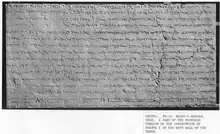Inscriptional Parthian
Inscriptional Parthian is a script used to write Parthian language on coins of Parthia from the time of Arsaces I of Parthia (250 BC). It was also used for inscriptions of Parthian (mostly on clay fragments) and later Sassanian periods (mostly on official inscriptions).
| Inscriptional Parthian | |
|---|---|
 Parthian version of Shapur I's inscription at Ka'ba-ye Zartosht | |
| Script type | |
Time period | 250 BC |
| Direction | right-to-left script |
| Languages | Parthian language |
| Related scripts | |
Parent systems | Aramaic alphabet
|
| ISO 15924 | |
| ISO 15924 | Prti (130), Inscriptional Parthian |
| Unicode | |
Unicode alias | Inscriptional Parthian |
| U+10B40–U+10B5F | |
Inscriptional Parthian script is written from right to left and the letters are not joined.

Letters
Inscriptional Parthian uses 22 letters:[1]
| Name[A] | Image | Text | IPA[2] |
|---|---|---|---|
| Aleph | 𐭀 | /a/, /aː/ | |
| Beth | 𐭁 | /b/, /v/ | |
| Gimel | 𐭂 | /g/, /j/ | |
| Daleth | 𐭃 | /d/, /j/ | |
| He | 𐭄 | /h/ | |
| Waw | 𐭅 | /v/, /r/ | |
| Zayin | 𐭆 | /z/ | |
| Heth | 𐭇 | /h/, /x/ | |
| Teth | 𐭈 | /t/ | |
| Yodh | 𐭉 | /j/, /ĕː/, /ĭː/ | |
| Kaph | 𐭊 | /k/ | |
| Lamedh | 𐭋 | /l/ | |
| Mem | 𐭌 | /m/ | |
| Nun | 𐭍 | /n/ | |
| Samekh | 𐭎 | /s/ | |
| Ayin | 𐭏 | /ʔ/ | |
| Pe | 𐭐 | /p/, /b/ | |
| Sadhe | 𐭑 | /s/ | |
| Qoph | 𐭒 | /q/ | |
| Resh | 𐭓 | /r/ | |
| Shin | 𐭔 | /ʃ/, /ʒ/ | |
| Taw | 𐭕 | /t/, /d/ |
Ligatures
Inscriptional Parthian uses seven standard ligatures:[1]
| Ligature | Sequence | |
|---|---|---|
| Image | Text | |
| 𐭂𐭅 | 𐭂 (gimel) + 𐭅 (waw) | |
| 𐭇𐭅 | 𐭇 (heth) + 𐭅 (waw) | |
| 𐭉𐭅 | 𐭉 (yodh) + 𐭅 (waw) | |
| 𐭍𐭅 | 𐭍 (nun) + 𐭅 (waw) | |
| 𐭏𐭋 | 𐭏 (ayin) + 𐭋 (lamedh) | |
| 𐭓𐭅 | 𐭓 (resh) + 𐭅 (waw) | |
| 𐭕𐭅 | 𐭕 (taw) + 𐭅 (waw) | |
The letters sadhe (𐭑) and nun (𐭍) have swash tails which typically trail under the following letter.[1] For example:
| Ligature | Sequence | |
|---|---|---|
| Image | Text | |
| 𐭍𐭍 | 𐭍 (nun) + 𐭍 (nun) | |
| 𐭍𐭃 | 𐭍 (nun) + 𐭃 (daleth) | |
Numbers
Inscriptional Parthian had its own numerals:
| Value | 1 | 2 | 3 | 4 | 10 | 20 | 100 | 1000 | |
|---|---|---|---|---|---|---|---|---|---|
| Sign | Image | ||||||||
| Text | 𐭘 | 𐭙 | 𐭚 | 𐭛 | 𐭜 | 𐭝 | 𐭞 | 𐭟 | |
Numbers are written right-to-left. Numbers without corresponding numerals are additive. For example, 158 is written as 𐭞𐭝𐭝𐭜𐭛𐭛 (100 + 20 + 20 + 10 + 4 + 4).[1]
Unicode
Inscriptional Parthian script was added to the Unicode Standard in October, 2009 with the release of version 5.2.
The Unicode block for Inscriptional Parthian is U+10B40–U+10B5F:
| Inscriptional Parthian[1][2] Official Unicode Consortium code chart (PDF) | ||||||||||||||||
| 0 | 1 | 2 | 3 | 4 | 5 | 6 | 7 | 8 | 9 | A | B | C | D | E | F | |
| U+10B4x | 𐭀 | 𐭁 | 𐭂 | 𐭃 | 𐭄 | 𐭅 | 𐭆 | 𐭇 | 𐭈 | 𐭉 | 𐭊 | 𐭋 | 𐭌 | 𐭍 | 𐭎 | 𐭏 |
| U+10B5x | 𐭐 | 𐭑 | 𐭒 | 𐭓 | 𐭔 | 𐭕 | 𐭘 | 𐭙 | 𐭚 | 𐭛 | 𐭜 | 𐭝 | 𐭞 | 𐭟 | ||
| Notes | ||||||||||||||||
References
- Everson, Michael; Pournader, Roozbeh (2007-08-24). "L2/07-207R: Proposal for encoding the Inscriptional Parthian, Inscriptional Pahlavi, and Psalter Pahlavi scripts in the SMP of the UCS" (PDF).
- Daniels, Peter T.; Bright, William, eds. (1996). The World's Writing Systems. Oxford University Press, Inc. pp. 518. ISBN 978-0195079937.